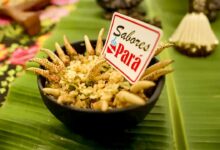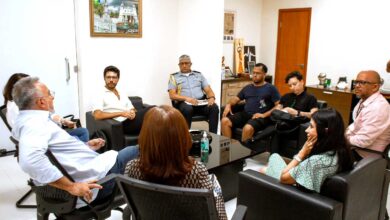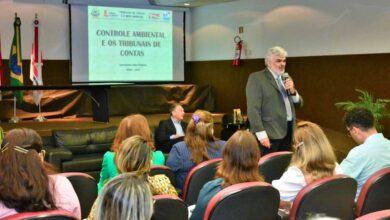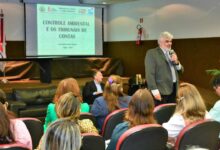
Ideflor-Bio conducts a botanical selection collection and processing course
Training takes place on the premises of the Forestry Management Unit of the Mamuru-Arapiuns tract of land, in the municipality of Juruti
The Institute for Forest Development and Biodiversity of the State of Pará (Ideflor-Bio), through the Directorate of Public Forest Management (DGFLOP), promotes, between December 6 and 10, the “1st Course of Collection, processing and identification of botanical samples”, for employees of the concessionaires that operate in public forests in the Mamuru-Arapiuns and Paru State Forest (Paru Flota).
The training is taking place at the premises of the Forest Management Unit (FMU-III) of the Mamuru-Arapiuns tract of land, in the municipality of Juruti, in the lower Amazon.
Twenty employees from the concession companies are taking part in the training, in addition to technicians from the Chico Mendes Institute for Biodiversity Conservation – Special Advanced Unit of Itaituba. The course will be given by Gracialda Ferreira, forest engineer, doctor in botany and director of (DGFLOP-IDEFLOR-Bio).

With a workload of 40 hours, the course activities were divided into theoretical classes, practices and methodologies.
Theoretical Activities – lectures, with approaches on the review of protocols that describe the step-by-step for the botanical collections and the activities applied in the processing (pressing, storage and treatment) of samples and information collected until they are sent for botanical identification procedures.
Practical Activities: take place in a forest area, to demonstrate and practice the stages of collection and processing of samples and the recognition of morphological structures and exercises for species identification.
Methodologies-taught with the objective of recognizing the morphological structures of plants and associating them with specific taxonomic groups (families, genera and species).
The training corresponds to the activities of the Forest Management Training Center, which is currently being implemented. This is a state public forest reserved by Decree No. 105 of June 20, 2011, with an area of approximately 34,000 hectares, located in the southern portion of the Curumucuri gleba, in the municipality of Juruti, forming part of the Mamuru-Arapiuns gleba, where it is surrounded by state and federal settlement projects, in addition to FMUs under state forest concession contracts.

As part of the management of public forests for forest production, training actions were started for professionals who work in forest management in the region where the public forest areas under forest concession are located.
The Training Center aims to promote the state forestry policy, technological development, technical and financial support to forestry activities in a sustainable way, through management practices that preserve the environment and ensure access to forest resources for future generations, with reduced environmental impact.
According to the director of Public Forest Management (DGFLOP-IDEFLOR-Bio), Gracialda Ferreira, the training is a demand from the concession companies that have been working with forest management for 11 years in the region. Botanical identification has been a recurring problem in management plans and operational plans. The forest inventory is the information base of the forests for forest management and production.

“The trees must be identified to determine the productive potential, the stock of raw material and to define the actions that involve the sustainability of the production of each forest”, said the director
Gracialda Ferreira , also points out that, since the beginning of forest harvesting in the Amazon, there is no procedure that allows the identification of the trees in a safe way. The usual procedure is to associate common names to the trees and then, in the office, associate these common names with scientific names, since the environmental licensing process requires by law that the plants are identified by their scientific names.
“This procedure has been generating recurrent errors of identification, which has been compromising the sustainability of forest management. A group of trees that receive the same common name and, consequently, associated with the same scientific name, may gather a set of species, since the association of the common name does not consider the set of morphological characteristics of the species”, said Gracialda Ferreira
As an example: when an identifier names several trees he calls “angelim-pedra”, he associates the name to the presence of the tree’s size, sometimes by observing sapopemas at the base and the bark detachment. However, these characteristics are common to at least six species of Hymenolobium, Dinizia, Enterolobium and Parkia, all genera of Fabaceae that include several species.

The same identifier adding other characteristics such as arrangement of leaves on the branches, number, size and shape of leaflets on the leaves, presence or absence of indument (hairs) and other reproductive characteristics (flower and/or fruit) would increase the number of species, because as the characteristics applied in the act of naming the trees are shared by different species he ends up grouping different species under the same common name.
The grouping may compromise the sustainability of the management, since rare species (represented by 1 to 3 trees per 100 hectares) are included with common species and it is not possible to detect these errors throughout the management process, except when the forest starts to decrease or lose its diversity.
The president of Ideflor-Bio, Karla Bengtson, explains that the course offered aims to sensitize identifiers and other professionals who work in forest management so that species identification errors are minimized or even eliminated, since the principle of forest management is guarantee the sustainability of the forest, which means maintaining the diversity of species, the productive potential of the forest and the environmental balance.
With information from the Pará agency











